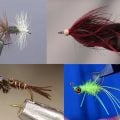How to Tie a Chuck Caddis
Producer: Tim Flagler
This is Eric Leiser’s Chuck Caddis. If you ask me, it’s the epitome of practical fly design. It’s extremely suggestive, has a straightforward tying sequence. Includes all natural, easy-to-find materials, and there’s no glitter or glue. This pattern of Mr. Leiser’s is the real deal.
I start with a Fulling Mill 35050 dry fly hook in size 14. After getting the hook firmly secured in the jaws of my tying vise, I load a bobbin with a spool of black UTC 70 Denier. Get your thread started on the hook shank leaving a 2 eye-length space behind the hook eye, and take a few wraps rearward before snipping off the tag. Continue taking thread wraps until your thread hangs at about the hook point.
Pull down on your bobbin to expose approximately 3” of tying thread. Although you can use woodchuck underfur for the body of the fly, I prefer natural hare’s mask as it’s generally easier to dub. Use the dubbing to create a slender 2” long noodle on your tying thread. Start taking wraps with the noodle so the dubbing begins right at the start of the hook bend. Then take touching wraps forward, ideally ending with bare thread at the initial tie-in point.
Not all woodchuck, ground hog, whistle pig or whatever you want to call it is created equal. Some skins don’t have a lot of color differentiation, while others have small patches of it. I like my woodchuck to have a good range of colors, especially at the guard hair tips, like this. Select and snip free from the hide a small clump. Get hold of the guard hairs by their tips and gently pull away the shorter underfur. It should slip out fairly easily. Place the remaining guard hairs, tips first, into a hair stacker and give them an ample stacking. Open the stacker so the tips point toward the rear of the fly and, while keeping those tips aligned, pull the clump from the stacker. Pass it to the fingers of your right hand then measure to form a wing that extends just a bit beyond the back edge of the hook bend. Squeeze the hair tightly in the fingertips of your left hand and start taking good firm thread wraps with your right. These guard hairs are a little slippery so make sure they’re bound down really well. Once secured, they should look something like this. Lift the butt ends up and use your tying scissors to snip them off at a shallow angle. This will allow you to take thread wraps forward to produce a smooth ramp from the base of the wing down to the hook shank. End with your tying thread almost back to the wing’s base.
Traditionally, one grizzly and one brown feather are used to hackle a Chuck Caddis but a single feather in the cree family will also get the job done. Here, I’m using, although it’s a bit hard to read because of the handwriting, a feather from a dark barred dun cape. I always like to measure a feather to make sure it’s the correct size before plucking it free from the skin. Flip the feather so the back or dull side is facing you and strip off any of the lower, fuzzy fibers. Then, remove a half dozen or so more fibers from the top of the stem. This will help the feather to wrap correctly. With the shiny side of the feather facing you, lay the stem against the near side of the hook and take thread wraps to secure it. Wrap down almost to the hook eye then back a little ways. Next reach in with your tying scissors, block the camera with your fingertips, and snip the excess butt end of the stem off close. Continue taking thread wraps rearward, and leave your tying thread right at the base of the wing. Pick up a pair of hackle pliers, here, plunger-style, and get hold of the feather’s very tip. Pull the feather back to kind of crease the stem, then start taking touching wraps with it rearward. This pattern does well with a fairly substantial hackle collar. When you reach your tying thread, give your bobbin a clockwise spin to cord up, strengthen and decrease the diameter of your thread. Then use it to anchor the feather’s stem but don’t snip the excess off just yet. Make sure your thread is still well corded then start taking touching wraps with it, forward through the hackle, counter wrapping the delicate stem as you go. When you reach the hook eye, pull the hackle fibers back and out of the way, and take thread wraps to hold them there. Reach for your whip finish tool and use it to do a 3 or 4 turn whip finish, seat the knot well and snip or cut your tying thread free.
Rather than snipping off the excess hackle tip, I reach for a sharp, fine-pointed hobby knife and place it’s blade at the feather’s base then pull down on the tip of the feather to drag it across the blade without accidentally trimming off any hackle fibers.
And that’s Eric Leiser’s Chuck Caddis. Just a marvel of simplicity, elegance and functionality.
How to Tie a Chubby Dry Fly
How to Tie a Cinder Worm











